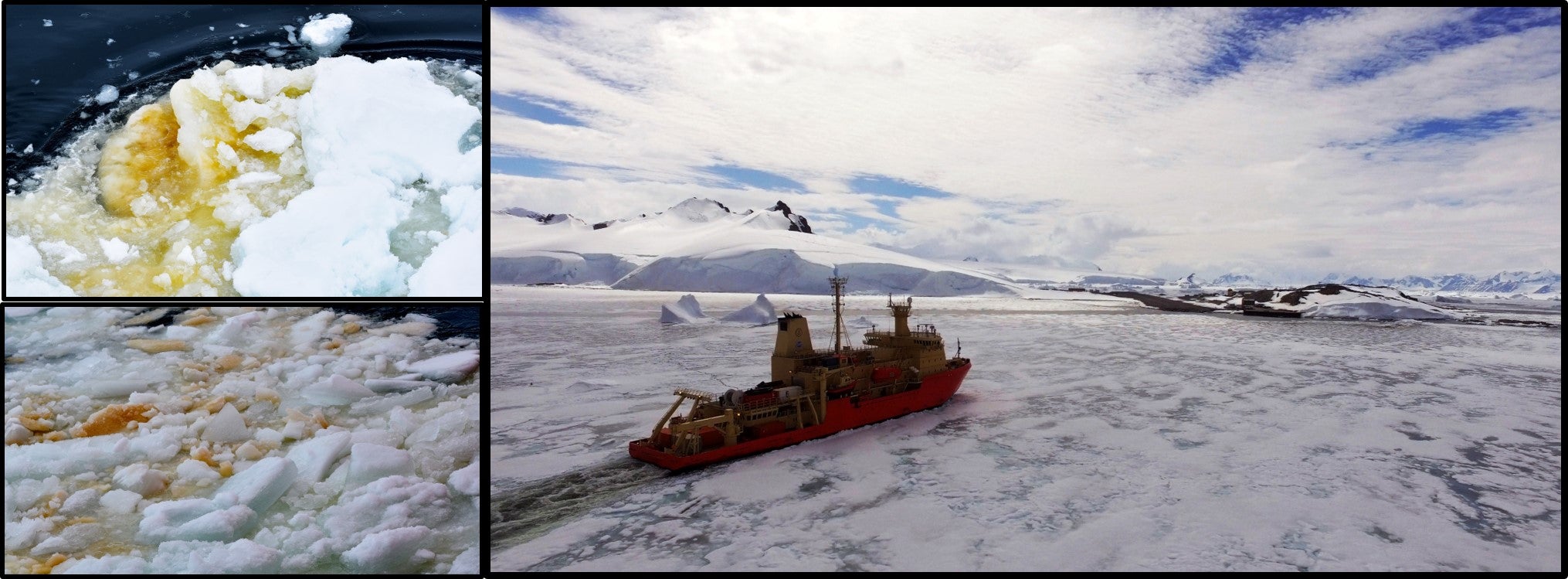Our excursion to the British Antarctic Station “Rothera” offered an opportunity for most of us to watch the R/V Nathaniel B Palmer’s incredible icebreaking capability as we navigated the ice-covered coastal waters on our approach to the base (Picture on the right). An interesting observation along this path was the presence of patches of brownish water, and ice floes with discolored bottoms being churned up from under the ice as we broke through (Pictures on the left). These brown “patches” are indeed full of life, and are blooms of diatoms – a form of algae that often thrive in these waters – especially in the overlying ice!
Approximately 20 million square kilometers of the Southern Ocean around Antarctica is blanketed by ice at least a meter (3.1 feet) thick, making it one of the planet’s major biomes. A network of micrometer to millimeter thick, brine-filled channels in this ice make it a porous matrix inhabited by a variety of microscopic organisms like viruses, bacteria, algae, single celled protists, and some small crustaceans. Diatoms – the organisms that interest us the most, often dominate these sea-ice communities, and the brown coloration in the ice and water seen in the picture are evidence of a thriving diatom population. These organisms form the base of the food web in these ecosystems, and are a primary source of food for krill in winter. Krill, which is the most abundant organism on this planet in terms of biomass (Krill stocks can exceed 1.5 billion tons, while the total biomass of people is around 0.5 billion tons), is a primary food source for squid, penguins, seals and baleen whales. The links between these organisms highlight just how critical these sea-ice communities are to sustaining an entire biome, and why recent reports of vanishing and/or reduced sea ice is an issue that needs to be taken seriously.
As phytoplankton ecologists, another feature that fascinates us is the ability of the diatoms to literally engineer their microenvironments. Diatoms, and bacteria associated with these diatoms are known to produce ice-active substances that can either modify the surfaces of the surrounding ice crystals, change their optical properties (an important detail if you depend on light to synthesize your food), or even nucleate/produce ice better than any known compound or mechanism. These features give these organisms a unique selective advantage in an otherwise harsh and unforgiving environment. We know very little about how these microenvironments contribute to the ecology of the sea-ice communities, and we hope to study these sometime in the not-too-distant future.
After a successful run of sampling in and around the Palmer LTER region, we’ve now set our sights on the open waters of the Amundsen sea. (Check out the “where is the NBP” link above to see where we are now).
Posted by: Dr. Nigel D’souza
Pic 1: The NBP cuts through ice on its approach to the British Antarctic Station Rothera. (Picture credit: The incredibly talented drone pilot at Rothera)
Pic 2: Sea Ice Algae seen in the wake of the ship

